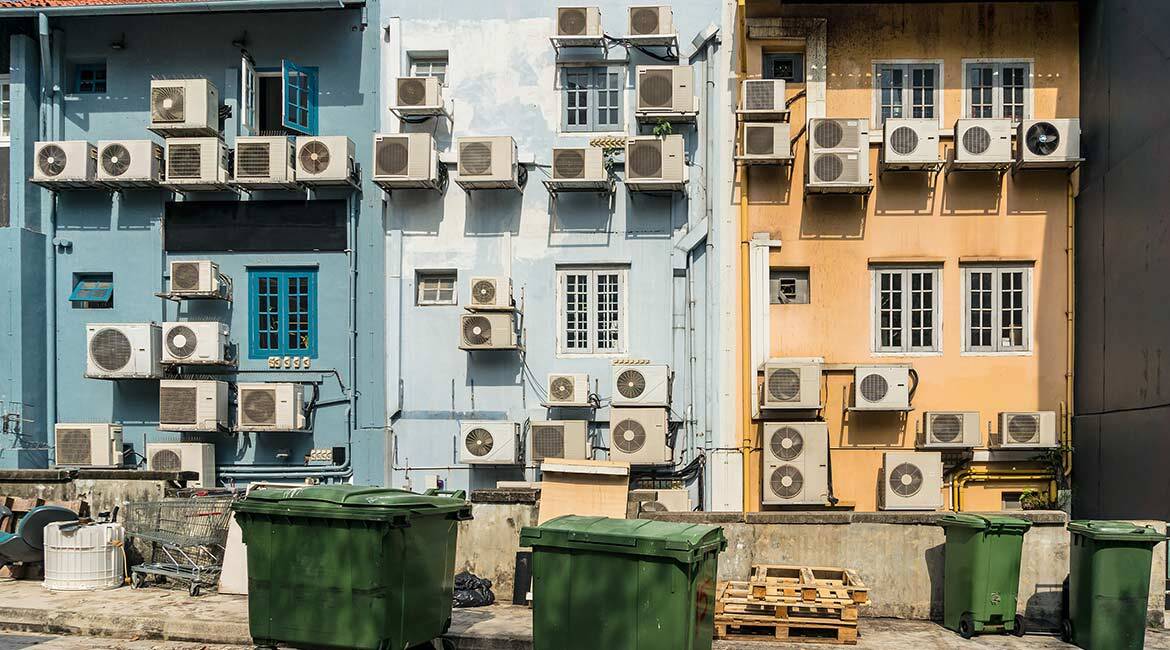Improving Heat Pump Performance with Solar Energy

Header image purchased on Istock.com. Protected by copyright.
Heat Pumps
We see more and more residential buildings equipped with air conditioning to maintain the comfort level of occupants during hot summer days. In the case of multi-unit buildings, it is not uncommon to see decentralized systems where each dwelling has its own system, as shown in Figure 1. Typically, a heat exchanger with a fan (also called a fan coil unit) is installed inside the apartment and the rest of the system is located directly on the balcony or on a wall bracket (Figure 1). The external part of the system includes a compressor and a second heat exchanger equipped with a fan that rejects heat into the outside ambient air during summer. These systems are often reversible: in addition to air conditioning, they can serve as a heating system. The system then acts as a “heat pump” since its function is to transfer heat from a cold environment to a warm one. In the summer, the heat pump keeps apartments cool while it is hot outside; in the winter it does the opposite. However, the performance in heating mode is affected by the outside ambient air temperature: the colder it is outside, the lower the performance of the heat pump will be, while at the same time, the building’s heating needs increase.
Figure 1 Multi-unit buildings equipped with air conditioning systems (photo taken in the Trois-Rivières area)
Coupling with Solar Collectors
To maintain the heat pump’s heating performance despite the decrease in temperature of the outside ambient air, solar collectors can be used, as the outdoor unit of the heat pump is usually installed on the balcony. If the facade of the building is exposed to the sun for much of the day, the glass panes of the balcony railings could simply be replaced with solar collectors. The idea is to use solar collectors to increase the heat pump evaporator capacity, consisting of a heat exchanger and a fan. This way, the sun’s energy is reclaimed, in addition to drawing in the cold outside air to evaporate the heat pump’s refrigerant (heat transfer fluid).
Photovoltaic Module
The advantage is twofold in the case of a photovoltaic (PV) module, a type of solar collector known to convert solar radiation into electricity. The efficiency of a PV module is about 15%. This value fluctuates according to the technology used, but it currently does not exceed 25%. However, such low efficiency leads to parasitic heating of the PV module being used. Its temperature can easily reach 50 °C under rated operating conditions.
Advantages of Coupling
Increasing the temperature of PV cells is detrimental as it reduces their electrical conversion efficiency. Thus, the performance of both the heat pump and the PV module are affected by a temperature variation. By combining these two systems, the heat of the solar collector can be used to boost the heat pump’s heating performance. At the same time, the solar collector’s operating temperature is reduced to maximize its electrical performance.
PV/T Solar Evaporator
To do this, a heat exchanger can be installed on the back of the solar collector, as shown in Figure 2a) and Figure 2b). The heat pump coolant evaporates behind the collector and reclaims its thermal energy. This constitutes a hybrid photovoltaic/thermal (PV/T) solar evaporator that produces both electricity and heat. In Figure 2a), a coil-shaped tube is used as the exchanger. This geometry has the advantage of providing a uniform and constant flow throughout the exchanger. The tube is attached to the back of the panel using an epoxy adhesive containing aluminum particles to maximize its thermal conductivity, as shown in Figure 2b).

Figure 2a) Coil-shaped heat exchanger installed at the back of a photovoltaic module; b) Epoxy glue used to attach the heat exchanger behind the solar collector
Types of Solar Collectors
Figure 2c) shows various solar collector concepts being tested on the Michel-Trottier HélioLAB rooftop of Pavilion A at Montréal’s École de technologie supérieure. On the left, the solar collector is simply made of a black-painted steel sheet and a coil-shaped tube glued to the back. In the centre, a hybrid PV/T solar collector includes PV cells, a steel sheet and a coil. On the right, a standard PV module (without heat exchanger) serves as a reference for electrical energy production. The solar collectors on the left and centre are connected in parallel to a CO2 transcritical heat pump prototype, developed in recent years. More details can be found on the Abscisse Énergie website.
Figure 2c) Different types of solar collectors installed on the rooftop of Pavilion A at Montréal’s École de technologie supérieure
Additional Information
The three types of solar absorber plate related to the three different solar collector geometries were modeled in detail in the following article:
- Paradis, P.-L., Rousse, D. R., Lamarche, L., & Nesreddine, H. (2017). A 2-D transient numerical heat transfer model of the solar absorber plate to improve PV/T solar collector systems. Solar Energy, 153, 366–378.
The photovoltaic/thermal hybrid solar evaporator simulation is described in the following article:
- Paradis, P.-L., Rousse, D. R., Lamarche, L., & Nesreddine, H. (2018). A hybrid PV/T solar evaporator using CO2: Numerical heat transfer model and simulation results. Solar Energy, 170, 1118–1129.
Finally, the use of a CO2 heat pump and a hot water storage tank for hot water production has also been studied in the following article:
- Paradis, Pierre-Luc, Daniel R. Rousse, Louis Lamarche, Hakim Nesreddine and Marie-Hélène Talbot. One-dimensional model of a stratified thermal storage tank with supercritical coiled heat exchanger. Applied Thermal Engineering, vol. 134, p. 379–395.


